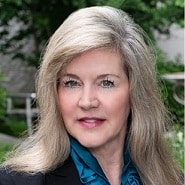
Tressa Springmann, SVP and CIDO, LifeBridge Health
In healthcare IT, there’s no shortage of areas that require attention. But, as some leaders are finding, it’s not always the major initiatives like an ERP rollout or EHR migration that place the most demand on resources. Sometimes, seemingly less urgent tasks like ensuring compliance with information blocking rules can take a large chunk of the pie.
“Those odds and ends add up,” said Tressa Springmann, SVP and Chief Information and Digital Officer, Lifebridge Health. During a session at the CHIME23 Fall Forum entitled, Beyond the Beltway: From AI to Cybersecurity, Insider Perspectives on Policymaking, Springmann and other members of CHIME’s Public Policy Steering Committee talked about their biggest priorities from a policy standpoint, what concerns them most heading into a new year, and why advocacy is so critical. Moderated by Tanya Townsend, Chief Information and Digital Officer at Stanford Medicine Children’s Health, the panel included: William Feaster, MD, Former Chief Health Information Officer, CHOC Children’s Hospital; Shafiq Rab, MD, Chief Digital Officer & System CIO, Tufts Medicine; and Donna Roach, CIO, University of Utah Hospitals and Clinics.
HTI-1 Proposed Rule
When the HT1-1 Proposed Rule was published — and made available for comments — this past spring, healthcare leaders had a lot to say. According to ONC, the proposed rule is designed to advance interoperability, improve transparency, and support the access, exchange, and use of electronic health information.
And while, on paper, that sounds like a step in the right direction, leaders voiced several concerns about some of the implications. For example, any organization that does work in conjunction with the EHR and assists in app development using any form of AI decision support can be considered a developer, said Roach. “That requires opening up your books and showing how you did that. To me, that is an unnecessary overreach into what we do from an academic research side.”

Donna Roach, CIO, University of Utah Health
In short, patients need to informed every time their data is included in an AI report, which can be detrimental to clinical workflows. “It’s burdensome and it slows down clinical care,” she said. “In this day and age where we’re trying to concern ourselves with clinician burnout, that is just adding to it.”
Generative AI
Artificial intelligence is undoubtedly one of the most exciting topics in healthcare, particularly in the context of large language models. And yet, “what we’ve done has been really limited,” said Feaster. However, the potential it holds to better predict outcomes is staggering. “We can only process about four to six pieces of data when we’re making decisions. These machines can process hundreds.”
And that’s just the start.
At CHOC Children’s, where he spent nearly 12 years, a large language model has been shown to chart reviews significantly faster than humans. Ambient voice recognition has been a huge time saver. “There’s so much going on in artificial intelligence,” he said. “I’d hate for all the good things it’s doing to get lost.”
Telehealth
When it comes to telehealth, there’s good news and bad news. The good news, of course, is that telehealth services will continue to be reimbursed through 2024. The bad news? The future beyond that is unclear, which puts both leaders and providers in an uncomfortable situation.

William Feaster, MD, Former Chief Health Information Officer, CHOC Children’s Hospital
“There still isn’t any permanency. It’s the ball that just keeps getting kicked forward,” said Springmann. “On a tactical level, we find ourselves in a situation where our providers are going back to what’s comfortable for them, but that’s in conflict with what many our consumers and patients want. That’s a very delicate balance to strike, especially in an industry where there are a lot of disruptors for that type of care.”
It’s also a tricky balance for leaders. “As we sit down to talk about strategy and what our virtual care future looks like, we can’t ignore the fact that reimbursement isn’t quite here to stay,” she noted. “It’s really hard to have that conversation at a strategic level.”
Cybersecurity
And then there’s cybersecurity, which could easily fill a session on its own. “There are so many bad actors,” said Roach. “They’re learning our systems faster than we can put measures in place to protect our systems.” Even obtaining cybersecurity insurance has become an uphill battle, particularly for academic organizations like Utah Health. “We’ve had a terrible time with it,” she noted.
And it isn’t going to change without significant help from the government. “There needs to be greater coordination in the laws that protect us. We need better awareness of what’s going on in the cybersecurity landscape.” The more involved leaders get in advocacy efforts, the more effectively their needs will be represented, said Roach, who urged attendees to be active at the state level and work to understand the culture of the state, which in turn will help improve understanding at the federal level.
Clinical burden
The final area of focus is clinical burden, which has resulted in too many providers leaving the field. “We want to provide the best care to patients, and we need people to provide that care,” said Feaster. “We talk about simplifying the administrative burden, but we’ve done nothing.” Although the digitization of medicine has made great strides in terms of increasing efficiency and improving care, it has also placed far too much of a load on those delivering care.

Shafiq Rab, MD, EVP/Chief Digital Officer & System CIO, Wellforce
“There’s too much pressure to be in compliance with all of these regulations,” he added. “I don’t see a lot happening now to facilitate our ability to provide good care. Let’s stop overregulating and provide a little simplification for our providers and our health systems so that we can provide better care to patients.”
Doing so is going to require a continued commitment among leaders to advocate for their organizations and for the industry. The best way to do that, according to Rab, is by participating in CHIME’s Policy Steering Committee, as he has for several years. “We try to take our voice to the people who make policies,” he said, giving credit to those working behind the scenes as well — particularly Mari Savickis, VP of Public Policy, and Chelsea Arnone, Director of Federal Affairs. “Without them, we would not be able to do extraordinary work.”


Share Your Thoughts
You must be logged in to post a comment.